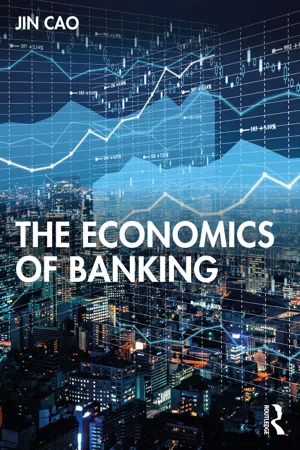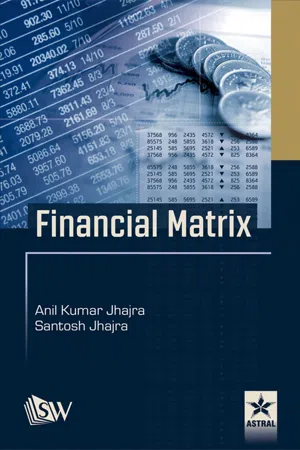Economics
Banking Industry
The banking industry refers to the network of financial institutions that provide various services, including accepting deposits, lending money, and facilitating financial transactions. It plays a crucial role in the economy by channeling funds from savers to borrowers and providing essential financial services to individuals, businesses, and governments. The industry is regulated to ensure stability and protect consumers.
Written by Perlego with AI-assistance
Related key terms
1 of 5
4 Key excerpts on "Banking Industry"
- eBook - ePub
- Jin Cao(Author)
- 2021(Publication Date)
- Routledge(Publisher)
PART I Introduction CHAPTER 1 Introduction DOI: 10.4324/9780429356773-2 1.1 What Are Banks and Why Are They Special? B anks are among some of the most important yet sometimes the most controversial institutions in an economy. Banks provide socially desirable services for households, firms, and other financial institutions, but bank failure often costs enormously for taxpayers and economic growth. In this chapter, we will take a brief look inside the Banking Industry, explain terms and jargon that we will use frequently in the rest of this book, and focus on the features in banking that make banks and the economics of banking special. According to Encyclopædia Britannica, a bank is “an institution that deals in money and its substitutes and provides other money-related services. In its role as a financial intermediary, a bank accepts deposits and makes loans”. That is, a bank provides financial intermediation services between lenders and borrowers, collecting funds from lenders and lending the funds to borrowers; of course, nowadays, we shall also interpret “deposits”, “loans”, “depositors”, and “borrowers” more broadly. In addition, the boundary between banks and other types of financial institutions is becoming more and more blurred, for example, certain financial institutions such as mutual funds also provide financial intermediation services. In the narrow sense, only a financial institution that carries a banking license that is issued by banking authority is legally classified as a bank - eBook - PDF
- S. Janssen(Author)
- 2009(Publication Date)
- Palgrave Macmillan(Publisher)
8 2 What Is a Bank? 2.1 Introduction Without discussing the theoretical question of what constitutes a financial intermediary at great length, this book accepts that there are financial inter- mediaries, such as banks, insurance companies and investment companies which are instrumental to the functioning of the financial markets as their activities provide the institutional framework. Clearly, there would not be any significant financial market without these financial institutions, nei- ther would there be any financial institution without the existence of such markets. The structure of a financial system is to a great extent contingent upon the institutions that make up the system. Unlike insurance and investment companies, banks play the most important role in maintaining the stability of a financial system. Therefore, this work focuses on banks, which makes it necessary to consider the definition of a “bank”. This can be approached in a threefold manner (Büschgen, 1993, pp. 9–26). Büschgen differentiates between a legal, a microeconomic and a macroeconomic definition of a bank – an approach that also appears functional for this book. Consequently, this chapter first provides an overview of the bank-specific directives adopted at EU level, and then outlines the legal definitions of a bank in the United Kingdom and Germany. The second half of this chapter considers the microeconomic definition of a bank, and concludes with the inextricably linked macroeconomic concept of a bank. 2.2 The rationale for banking regulation Prior to the discussion of a bank’s legal status in the EU, the United Kingdom and Germany, it is necessary to explain why the banking sector is so heavily regulated. The banks’ pivotal role within the financial system essentially stems from their transformation function, which implies the matching of monetary surplus and deficit units (Mishkin, 1986; Howells & Bain, 2002). - eBook - PDF
- Jhajra, Anil Kumar(Authors)
- 2021(Publication Date)
- Scholars World(Publisher)
Chapter 7 Banking Sector in India Banking Industry in India has always revolved around the traditional function of deposits and credit. Their role had been defined as to assist the overall economic growth with majority of share being controlled by the Government of India in most of the banks. But with the process of liberalization, the Banking Industry has also undergone tremendous change in the last 5 years. The market, which was largely controlled by the public sector banks, has now been facing stiff competition not only from foreign players but also from the new generation private sector banks. The rules of the game have been changing with the RBI introducing new norms to make banks more accountable and to adopt the practices followed worldwide. Most of the banks have now been trying to function on the concept of a Universal Bank. Apart from the traditional functions of a commercial bank, they are taking steps to build themselves into a one stop financial centre wherein all the financial products would be available. Banks have started catering to the retail segment to improve their deposit portfolio. In order to have a maximum share in this segment, most of the banks have been introducing new products. The delivery channels have also been shifted from branches to ATMs, phone banking, net banking etc. Technology has become an important medium of not only attracting new customers but also in retaining them. The new generation private sector banks have made a strong presence in the most lucrative business areas in the country because of technology upgradation. While, their operating expenses have been falling as compared to the PSU banks, their efficiency ratios (employee’s productivity and profitability ratios) have also improved significantly. Mergers and Acquisitions have also started playing their role in the This ebook is exclusively for this university only. Cannot be resold/distributed. - eBook - PDF
- Hans Keiding(Author)
- 2017(Publication Date)
- Red Globe Press(Publisher)
Private banking may, however, contain business contracted with firms of considerable size, up to the servicing of the corporate sector, which belongs to the next category. In the field of private banking we shall find most of what will concern us in the chapters to follow. However, the fact that banks typically do other kinds of business – and get much of their earnings from this – means that we will have to make occasional detours into other fields of finance. Commercial banking. The terminology is not altogether fixed, and in some contexts com-mercial banking means all banking business which does not fall into the realm of invest-ment banking (buying and selling firms, arranging mergers and acquisitions). However, we shall use it in the more common meaning of providing banking services (funding arrange-ments and other banking business) for corporate firms. It is clear from this description that only banks of su ffi cient size are engaged in commercial banking. Investment banking (corporate finance). As mentioned already, investment banking deals with problems of long-term financing of the corporate sector, either through purchases of firms by others or through introduction of firms to the stock exchange (so-called IPOs, initial public o ff erings, to be dealt with in Chapter 9). Although the individual business transactions are often very lucrative for the bank, the amount of business is highly volatile and subject to cyclical movements. Payment and settlement . Financial intermediaries are increasingly involved in payment services, both national and international, and although the fee to be gained from any single transaction is small, the total sums transferred are such that the earnings are interesting. We shall return to specific banking problems related to payments in a later chapter. Asset management takes care of the placement of large sums of money in securities as well as the task of matching the payments of assets and liabilities.
Index pages curate the most relevant extracts from our library of academic textbooks. They’ve been created using an in-house natural language model (NLM), each adding context and meaning to key research topics.



